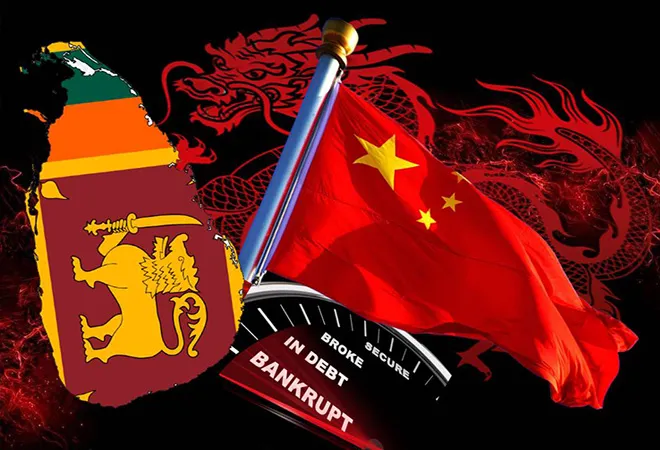-
CENTRES
Progammes & Centres
Location
Beijing's passive approach has encouraged the policy banks to make decisions based on its economic interests thus slowing down Sri Lanka’s debt restructuring process

This is the 147th in the series–The China Chronicles.
During his recent visit to China in June, Sri Lanka’s Foreign Minister Ali Sabry met his Chinese counterpart, Qin Gang; the Finance Minister of China, Liu Kun; and the Chairman of EXIM Bank (ChEXIM), Wu Fulin. Following these meetings, China offered assurances of bilateral support but declined to join the official creditors’ platform. This means that China will not negotiate a common debt restructuring plan for Sri Lanka with India, Japan, and the Paris Club. China’s decision has increased the complexities of Sri Lanka’s debt restructuring before its first International Monetary Fund (IMF) review in September—as failing to debt restructure might lead to the suspension of the current assistance programme.
Beijing’s decision is likely an outcome of two main factors, namely, geopolitics and the role of policy banks in loan restructuring. Whilst the first factor is common knowledge, less has been written about the Chinese policy banks and loan restructuring in Sri Lanka. Chinese policy banks are state-owned banks that were established to promote policy-oriented funding and lending. They tend to achieve the objectives of a state such as financing infrastructure and basic industries, investing abroad, etc. They play a crucial role in debt restructuring, depending on the autonomy accorded by the government.
China is Sri Lanka’s largest bilateral creditor. As of June 2022, it accounted for over 21 percent of Sri Lanka’s total outstanding debt, i.e. US$8.5 billion. A majority of Sri Lanka’s borrowings from China are from the policy banks. To understand the role of policy banks in Sri Lanka’s debt crisis, it is vital to understand the crucial players involved in Chinese lending.
China’s decision has increased the complexities of Sri Lanka’s debt restructuring before its first International Monetary Fund (IMF) review in September—as failing to debt restructure might lead to the suspension of the current assistance programme.
First, the government plays a crucial role in determining the nature of assistance given to proposed projects. Broadly, the Chinese government offers two types of support: Overseas development assistance (aid, concessional loans and interest-free loans) and official assistance (loans with interest at market rates or higher than market rates). The Chinese Ministry of Finance and Ministry of Foreign Affairs often take a call on the nature of the assistance given after reviewing the proposals submitted to the Chinese missions by the recipient countries. This decision is shaped by the government’s political and economic interests. The policy banks then decide the fate of these projects. These banks are tasked to generate financial returns and profits, and, as a result, they often decide to fund projects at market rates.
Practically speaking, banks can refuse to finance projects if deemed unviable, but since they are managed by top Communist Party of China (CPC) cadres, the government's initiatives and interests frequently take precedence. The prospect of the Belt and Road Initiative (BRI) countries getting easily financed with some leniency on conditionalities further substantiates this argument. And, in cases where the government decides to fund projects on concessional loans, the banks ask the former to cover the gap between commercial and concessional loan rates.
The government plays a crucial role in determining the nature of assistance given to proposed projects.
The policy banks then lend the finances to profit-seeking Chinese State-Owned Enterprises (SOEs) that are often in search of contracts in other countries. The SOEs are thus expected to implement the project in the recipient country. These SOEs are also managed by the CPC cadres and entrusted to promote Chinese economic interests, such as generating revenues; expanding the role, share, and function of Chinese SOEs; promoting Chinese production and supply chains; and increasing forex reserves.
Since the 2000s, China’s interest in Sri Lanka has increased, given its increasing global ambitions and Sri Lanka’s crucial geopolitical positioning. Beijing's engagements increased with its efforts to “rebuild Sri Lanka” following the 2004 Indian Ocean Tsunami and during the final years of the Civil War (2006-2009). This relationship has only grown ever since.
The Chinese government’s interest in Sri Lanka paved the way for more investments in the island nation. The investments are financed with both concessional and commercial loans. Incidentally, Chinese contribution to Sri Lanka’s debt stock increased from 0.3 percent in the 1990s to more than 21 percent in 2022. Three factors contributed to this increase: One, Sri Lanka’s demand for certain projects; two, lobbying by Chinese SOEs that motivated the Sri Lankan government to propose new projects; three, China’s political interest in Sri Lanka providing the direction for Chinese policy banks and SOEs to invest in the country; and also contributing to easy grant of funding and projects. Essentially, two policy banks—ChEXIM and China Development Bank (CDB)—emerged as top lenders.
ChEXIM has lent around US$4.3 billion to Sri Lanka. These lendings have largely been project-specific and have boosted the presence and activities of SOEs in the country. The first commercial lending project in Sri Lanka was funded by ChEXIM in 2001. Ever since, the bank has offered significant loans for Chinese SOEs to promote infrastructure, such as airports, sea ports, coal plants, expressways, railways, etc. Most of these projects expanded in the subsequent years and coincided with other BRI projects. However, ChEXIM has also contributed to some widely known white elephant projects—such as Hambantota Port, Mattala Rajapaksa International Airport, and the Lotus Tower.
The Chinese government’s interest in Sri Lanka paved the way for more investments in the island nation.
On the other hand, CDB has lent around US$3.0 billion to Sri Lanka. The bank began investing in Sri Lanka only in 2011, but its funds were limited in scope and extent. In Sri Lanka, CDB focuses on refinancing loans, rather than project-specific funding, majorly acting as a balance of payment supporter. In 2018, CDB offered Sri Lanka a funding facility of US$1 billion. Similar facilities of US$500 million and US$700 million were issued in 2020 and 2021.
As signs of economic distress grew in 2022, Sri Lanka sought an assistance of US$4 billion from China—this included a fresh loan of US$1 billion, a credit line of US$1.5 billion, and resuming of a currency swap worth US$1.5 billion. Considering that the requested assistance was not project-specific, it was anticipated that the CDB would assist Sri Lanka. However, these requests were shelved. Colombo's requests for debt restructuring were re-commenced following the IMF staff-level agreement in September 2022.
In March 2023, China became the last country to assure the IMF of debt restructuring, albeit hesitantly and half-heartedly. While most countries have restructured their loans for 10 years, ChEXIM has offered a moratorium of only two years. On the other hand, no such assurances were offered by CDB. Minister Sabry’s latest meeting with the Chairman of ChEXIM further indicates that CDB continues to be out of the debt restructuring process. Sri Lanka’s last request for debt restructuring to the CDB was in November 2022. To complicate matters, China has also declined to join the official creditors’ platform since the banks do not want to compromise on their privilege clause, which keeps them out of collective restructuring.
In March 2023, China became the last country to assure the IMF of debt restructuring, albeit hesitantly and half-heartedly.
It appears that restructuring efforts have been half-hearted due to a lack of political will in China. To be clear, China has not been lenient on debt restructuring. It had rejected similar requests from Sri Lanka in 2014 and 2017 but had often refinanced or offered new loans. However, these alternatives are absent this time, even when a crisis-hit Pakistan continued receiving fresh loans. This passivity for Sri Lanka is due to a series of differences between Beijing and Colombo since late-2021, such as a tussle over the fertiliser issue, the cancellation of a Chinese solar project in Northern Sri Lanka, Sri Lanka’s approaching of the IMF, and the unilateral cancellation of debt repayments.
As a result, there is a possibility is that Beijing has become passive and left the profit-seeking SOEs and policy banks to chart the way ahead in Sri Lanka, even as new Chinese investments continue to flow in. The second possibility is that the Chinese government is restructuring loans where it expects minimal economic and political costs. It has partially restructured ChEXIM loans that are both concessional and commercial while leaving all of CDB’s (commercial) loans untouched. This strategy will also deter China from setting a precedent to other countries that are seeking debt-restructuring talks with Beijing.
Overall, Chinese policy banks have played a significant role in furthering Chinese interests in Sri Lanka. In practice, they tend to enjoy some autonomy in lending and decision-making, but they have often lined up with the government for political or economic reasons. However, in the case of Sri Lanka’s debt restructuring, Beijing's passive approach has encouraged the policy banks to make decisions based on its economic interests. Thus, contributing to a slow process of restructuring, and also indicating the crucial role of the Chinese government in restructuring Sri Lanka’s debts.
Aditya Gowdara Shivamurthy is a Junior Fellow with the Strategic Studies Programme at the Observer Research Foundation.
The views expressed above belong to the author(s). ORF research and analyses now available on Telegram! Click here to access our curated content — blogs, longforms and interviews.

Aditya Gowdara Shivamurthy is an Associate Fellow with the Strategic Studies Programme’s Neighbourhood Studies Initiative. He focuses on strategic and security-related developments in the South Asian ...
Read More +